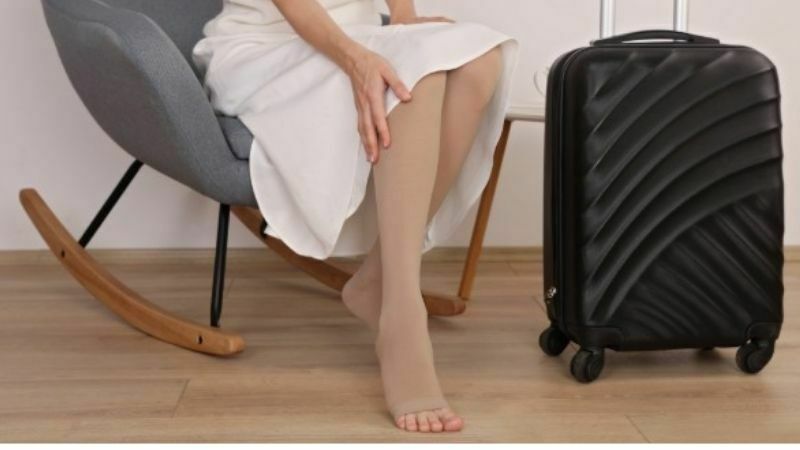Research says that long journeys (4 hours and above) increase the risk of blood clots forming in your leg veins. This is because traveling requires you to spend long hours sitting in a crowded space or standing in long lines. Restricted movement can also raise the risk of developing other venous disorders. If you already have varicose veins, traveling can increase your discomfort and even make the condition worse.
However, vein problems should not prevent you from going on a trip. Instead, it would help to consider a few tips for traveling with varicose veins to ensure your journey goes well. Though these tips are well researched to make your travel safe and painless, your doctor can advise you on the best for your situation.
How Do You Travel With Varicose Veins?
Long journeys can put your vein health at risk and take a toll on your circulatory system. When seated for long hours, circulation slows down, and blood pools in our legs. Those with varicose and spider veins can cause severe leg pain and discomfort. Travelling can also make your venous condition worse.
Travelling Can Affect Your Legs In The Following Ways:
- Lack of movement can cause blood to pool in the legs
- Can aggravate the problem of varicose veins
- Increase swelling in the legs and feet
- Induce leg pain
- Increase in the probability of blood clots (DVT)
Things To Avoid When You Travel With Varicose Veins
- Avoid wearing tight clothing
- Do not wear high heel shoes
- Avoid alcohol
Tips For Travelling With Varicose Veins
Traveling with varicose veins can be a daunting experience, but it should not deter you from enjoying a holiday with your loved ones and making memories. You can minimize travel risk with varicose veins with simple steps.

Elevate Your Legs When Possible
When you raise your legs, you reduce the pressure on your lower legs, making it more straightforward for the blood to return to your heart. If it is impossible to elevate your legs during the trip, try doing so when you reach your destination or at the end of the day to relieve any symptoms of pain and swelling caused due to the trip.
Leg Exercises
Relieve the strain on your legs and feet by exercising on the go. This can help boost blood circulation and help prevent any pain and swelling. Pick exercises for varicose veins targeting the ankles and feet, such as ankle rotations, foot flexes, and calf raises.
For example, to do foot flexes, pull your toes back towards your body for 10 seconds, then point your feet down for 10 seconds. Do this a few times with each foot to keep your leg muscles active.
Take A Break From Sitting
To alleviate the pressure from prolonged sitting, you must walk around as often as possible. For example, stand up and walk around the aircraft if you are on a flight. If traveling by road, make regular stops to stretch your legs and activate your calf muscles. Calf muscles aid in blood circulation; thus, moving them boosts your vein health.
Wear Compression Stockings
Whether you have varicose veins, compression stockings are a must while traveling. They apply graduated pressure on your veins, thus promoting the return of blood back up to the heart.
Medical compression stockings can help ease discomfort and minimize swelling during travel if you already have varicose veins.
Using stockings for long-distance travel has been proven to minimize the risk of deep vein thrombosis in people with conventional risk factors. In addition, compression stockings for varicose veins provide extra protection and support for your veins.
Wear Loose Clothing
Wearing loose clothing when traveling allows you to be relaxed. However, tight clothes can restrict your movement, make you uncomfortable and disrupt your blood flow, especially if you wear the same clothes for prolonged hours.
Hydrate Yourself
Staying hydrated allows your muscles to function correctly. Furthermore, the more water you drink, the more chances you will need to stop for a bathroom break, which means you’ll have to get up and walk more frequently.
Drinking water and staying hydrated is one of the finest tips for traveling with varicose veins since it promotes healthy blood flow. Your blood will be thinner when adequately hydrated, making it easier for your body to circulate it and keeping additional vein issues at bay.
Conclusion
We are confident that following these easy recommendations and tips for traveling with varicose veins will benefit you and allow you to enjoy your journey and vacation without worry. You can also talk to your doctor about how compression stockings for varicose veins can help you.
Frequently Asked Questions
Q1. How do you travel with varicose veins?
Varicose veins should not deter you from traveling or taking a long flight. However, you must wear compression stockings during your trip, stay hydrated, walk around, and stretch regularly.
Q2. Is it OK to travel with varicose veins?
Yes, it is entirely okay to travel with varicose veins, but you must take specific precautionary measures to safeguard your travel. It is a good idea to consult a specialist to discuss the risk factors and actions you can take to deal with varicose veins during your trip.
Q3. Is it better to sit or stand with varicose veins?
Prolonged standing and sitting are not ideal for people suffering from varicose veins. These actions negatively impact blood circulation and can worsen your varicose veins. Instead, stay active and move around as frequently as possible. If sitting or standing for long hours cannot be avoided, try using compression stockings to boost blood flow.
Q4. What clothes to wear to cover varicose veins?
Compression stockings are the most practical solution for living with varicose veins. They not only assist in camouflaging them but also help manage the symptoms and prevent the condition’s advancement. If you suffer from varicose veins, avoid wearing tight clothes, which can further disrupt your blood circulation.


Comments
There are no comments yet.